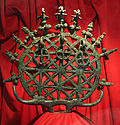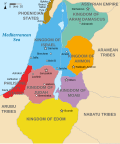The Iron Age Greek migrations occurred from the middle of the 11th century to the end of the 9th century BCE (the Greek Dark Ages). The movements resulted...
19 KB (2,134 words) - 21:35, 2 January 2025
portal Greek Dark Ages – period following the Late Bronze Age collapse Iron Age Cold Epoch Middle Bronze Age migrations (ancient Near East) Migration Period –...
68 KB (8,960 words) - 03:42, 6 July 2025
Iron Age of Prehistoric Ireland begins around 500 BC, when the Greek Iron Age had already ended, and finishes around 400 AD. The use of iron and iron-working...
36 KB (4,734 words) - 23:34, 15 June 2025
The Iron Age (c. 1200 – c. 550 BC) is the final epoch of the three historical Metal Ages, after the Copper Age and Bronze Age. It has also been considered...
69 KB (6,792 words) - 04:32, 22 July 2025
the Black Sea. The Archaic expansion differed from the Iron Age migrations of the Greek Dark Ages, in that it consisted of organised direction (see oikistes)...
72 KB (6,710 words) - 09:51, 19 July 2025
Archaeology of Northern Europe (redirect from Pre-Roman Iron Age (Northern Europe))
the Nordic Bronze Age. The tripartite division of the Nordic Iron Age into "Pre-Roman Iron Age", "Roman Iron Age" and "Germanic Iron Age" is due to Swedish...
27 KB (2,739 words) - 12:15, 10 July 2025
Hillfort (redirect from Iron Age Hill Towns)
5 million lived in Europe; in the Late Iron Age it had an estimated population of around 15 to 30 million. Outside Greece and Italy, which were more densely...
35 KB (4,106 words) - 06:05, 22 July 2025
Late Bronze Age collapse Dorian invasion Greek Dark Ages Iron Age Greek migrations History of ancient Greece (timeline) Archaic Greece Greek colonisation...
26 KB (2,173 words) - 07:43, 22 January 2025
The Indo-European migrations are hypothesized migrations of peoples who spoke Proto-Indo-European (PIE) and the derived Indo-European languages, which...
269 KB (29,586 words) - 05:46, 13 July 2025
The Migration Period (c. 300 to 600 AD), also known as the Barbarian Invasions, was a period in European history marked by large-scale migrations that...
38 KB (4,383 words) - 18:11, 17 July 2025
British Iron Age is a conventional name used in the archaeology of Great Britain, referring to the prehistoric and protohistoric phases of the Iron Age culture...
36 KB (4,443 words) - 08:15, 13 June 2025
subcontinent, the Iron Age succeeded Bronze Age India and partly corresponds with the megalithic cultures of South India. Other Iron Age archaeological cultures...
11 KB (1,291 words) - 23:20, 29 June 2025
Swords made of iron (as opposed to bronze) appear from the Early Iron Age (c. 12th century BC),[citation needed] but do not become widespread before the...
11 KB (1,469 words) - 06:44, 11 July 2025
The Indo-Aryan migrations were the migrations into the Indian subcontinent of Indo-Aryan peoples, an ethnolinguistic group that spoke Indo-Aryan languages...
240 KB (28,103 words) - 06:08, 19 July 2025
period of Greek history, which had a powerful influence on the later Roman Empire. Part of the broader era of classical antiquity, the classical Greek era ended...
62 KB (9,017 words) - 08:46, 17 July 2025
migrations eastwards, as this technology had been well known for quite a while in western regions. It is further conjectured that the same migrations...
104 KB (12,032 words) - 16:48, 22 July 2025
Dorian invasion (redirect from Dorian Migrations)
the Early Iron Age, and to have combined earlier mythic traditions concerning the Dorians and the Heracleidae. Two further Dorian migrations were believed...
76 KB (9,166 words) - 00:31, 12 July 2025
Protogeometric style (category Iron Age Greek art)
Ancient Greek pottery led by Athens and produced, in Attica and Central Greece, between roughly 1025 and 900 BCE, during the Greek Dark Ages. It was succeeded...
7 KB (749 words) - 09:47, 11 May 2025
Prehistoric sites in Serbia (redirect from Iron Age Serbia)
Bronze Age this area has seen several large migrations of various Indo-European groups, some of whom become permanently settled. During the Iron Age lower...
24 KB (2,255 words) - 01:05, 10 March 2025
Greece prior to the emergence of the Proto-Greek language in the region c. 3200–2200 BC, during the Early Helladic period. About 1,000 words of Greek...
45 KB (4,376 words) - 05:47, 10 July 2025
Western Steppe Herders (category Bronze Age Europe)
early Bronze Age, the Early European Farmer (EEF) cultures of Europe were overwhelmed by successive migrations of WSHs. These migrations led to EEF paternal...
58 KB (6,356 words) - 06:47, 19 July 2025
Philistines (category Articles containing Ancient Greek (to 1453)-language text)
Koinē Greek: Φυλιστιείμ, romanized: Phulistieím; Latin: Philistaei) were ancient people who lived on the south coast of Canaan during the Iron Age in a...
120 KB (14,475 words) - 15:59, 20 July 2025
Bloc. In Greece, a highly militarized area called the "Επιτηρούμενη Ζώνη" ("Surveillance Area") was created by the Greek Army along the Greek-Bulgarian...
77 KB (8,716 words) - 00:42, 18 July 2025
Ancient history (redirect from Ancient age)
in late antiquity. The three-age system periodises ancient history into the Stone Age, the Bronze Age, and the Iron Age, with recorded history generally...
105 KB (12,287 words) - 10:22, 15 July 2025
Greek (Modern Greek: Ελληνικά, romanized: Elliniká, [eliniˈka] ; Ancient Greek: Ἑλληνική, romanized: Hellēnikḗ, [helːɛːnikɛ́ː]) is an Indo-European language...
71 KB (7,241 words) - 12:05, 14 July 2025
ancient Greek tribes (Ancient Greek: Ἑλλήνων ἔθνη) were groups of Greek-speaking populations living in Greece, Cyprus, and the various Greek colonies...
32 KB (3,095 words) - 21:28, 1 May 2025
prehistorical migration since the Neolithic period until AD 1800. See Early human migrations for migration prior to the Neolithic, History of human migration for...
45 KB (5,077 words) - 19:17, 26 May 2025
Prehistoric Europe (redirect from Stone Age Europe)
an Iron Age evolution of the Urnfield culture. Around then, the Phoenicians, benefitting from the disappearance of the Greek maritime power (Greek Dark...
87 KB (8,855 words) - 11:09, 12 July 2025
Geometric art (redirect from Geometric Greek art)
a phase of Greek art, characterized largely by geometric motifs in vase painting, that flourished towards the end of the Greek Dark Ages and a little...
24 KB (2,523 words) - 19:43, 28 May 2025























